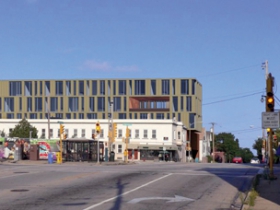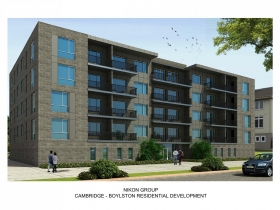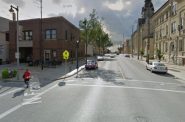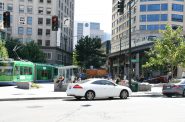The Rise of Parking-Free Apartment Buildings
Cities across America are slashing the cost of housing by reducing parking in new construction, how about Milwaukee?

Milwaukee has had is share of projects killed due to a “lack of parking.” In June 2007, this $7 million project, Mod Lofts, was to be built on a city owned parking lot, 2254 S. Allis St., in Bay View. The project fell apart due to a city requirement to replace the existing 38 public parking spaces. To date the site has yet to be redeveloped. According to Bay View Now, Ald. Zielinski said he would not support reducing the number of parking spaces, nor providing city subsidy for the project.
A wave of new residential construction projects in places like Seattle, Boston, and Miami are showing that, yes, modern American cities can build housing without any car parking on site.
Officials in Boston gave their approval to what Curbed called the city’s “first big-time parking-less condo,” a 175-unit project named Lovejoy Wharf. The “plan was met with disbelief in some quarters,” according to Curbed, but the city’s redevelopment authority approved it unanimously.
Portland developers have been building housing sans parking for a few years. Last summer, NPR reported that about 40 percent of Portland’s under-construction housing was parking-free. Portland’s zoning rules have allowed zero-parking developments since the aughts, but builders and lenders weren’t pursuing that type of project until recently, the Oregonian reports. Unfortunately, the city pulled the rug out from under parking-free housing this summer, responding to car owners who feared increased competition for curbside parking spots. Portland’s new rule requires some parking in apartment buildings with more than 30 units.
Meanwhile, other cities are marching ahead. In Seattle, parking-free housing developments are becoming more common. Mark Knoll, CEO of Blueprint Capital, led the development of a 30-unit building with no parking in one of the city’s “urban villages.” These designated areas, chosen for their walkability and proximity to transit, have special zoning rules that allow Seattle developers to forgo parking. These relaxed parking requirements were set in motion by Washington state’s Growth Management Act in the 1990s, which was intended to combat urban sprawl. Since the new zoning rules came online in Seattle in 2010, between 20 and 30 parking-free projects have been developed, Knoll estimates.

The Lower East Side has seen its share of developments stopped over “parking concerns.” Earlier this year, a proposed 40-unit apartment building, 1400 E. Boylston St., which would have had 41-parking spots, was opposed by neighbors due to density and parking, as expressed in the “Reasons for signing” section of this petition. To date the lot is still vacant.
Car parking is expensive: Each space in a city garage costs tens of thousands of dollars to build and hundreds of dollars annually to maintain [PDF]. Eliminating on-site parking brings down the cost of apartment construction, Knoll estimates, between 20 and 30 percent. That makes it possible for developers to deliver more affordable housing. Knoll’s California Avenue development, for instance, is targeted at people making 60 percent of area median income, or about $15 per hour.
“There’s been quite a few developments [of this type] and they’re quite popular,” said Knoll. “There’s a waiting list for these types of housing.”
Parking-free housing is attracting buyers at the upper end of the spectrum too. Luxury apartments and condos are now appearing in cities like Miami and Portland without any car parking. Miami’s under-development, 352-unit Centro Lofts will have just five Car2Go spaces, covered bicycle parking, and a space for a future bike sharing station. No storage for private cars. That doesn’t seem to be hurting demand, according to the Miami Herald:
If you think this sort of thing won’t fly in auto-centric Miami, guess again. Half of Centro’s 352 units are sold even though the building hasn’t broken ground. Prices start at $220,000 and top out in the mid-$400,000s.
“These types of projects are really the wave of the future,’’ Oscar Rodriguez, the developer, told the Herald.
The Milwaukee Situation
Parking has definitely been an issue with development in Milwaukee. As a market, developers and Department of City Development have progressed to a point where they’re pushing for less and less parking on each subsequent project. Unfortunately, the attitude of many residents hasn’t changed.
On North Avenue, the developers of The Standard at East Library are undergoing a tremendous expense to replace all of the parking that was formerly on the site as well as providing parking for every new apartment unit (at a ratio of one stall per bedroom, or greater than one per unit). Those apartments certainly would have been cheaper long-term if HSI Properties didn’t have to build underground parking from lot line to lot line.
This analysis touches on only a few of the buildings proposed or under construction in the past year, and doesn’t consider all the proposals that can never get off the drawing board because the pro-formas don’t pencil out when loss leading parking stalls are figured in. Mandating more parking than the market is demanding is lessening the ability of Milwaukee to take advantage of its density. – Jeramey Jannene
This story originally ran on Streetsblog. Angie Schmitt is a newspaper reporter-turned planner/advocate who manages the Streetsblog Network from glamorous Cleveland, Ohio. She also writes about urban issues particular to the industrial Midwest at Rustwire.com.
Political Contributions Tracker
Displaying political contributions between people mentioned in this story. Learn more.
Streetsblog
-
Car Culture Cements Suburban Politics
![Sprawl. Photo by David Shankbone (David Shankbone) [GFDL (http://www.gnu.org/copyleft/fdl.html) or CC-BY-SA-3.0 (http://creativecommons.org/licenses/by-sa/3.0/)], via Wikimedia Commons [ https://commons.wikimedia.org/wiki/File%3ASuburbia_by_David_Shankbone.jpg ]](https://urbanmilwaukee.com/wp-content/uploads/2017/10/1024px-Suburbia_by_David_Shankbone-185x122.jpg) Nov 23rd, 2018 by Angie Schmitt
Nov 23rd, 2018 by Angie Schmitt
-
Most Drivers Don’t Yield to Pedestrians
 Mar 22nd, 2018 by Angie Schmitt
Mar 22nd, 2018 by Angie Schmitt
-
Jobs Up Yet Driving Down in Seattle
 Feb 22nd, 2018 by Angie Schmitt
Feb 22nd, 2018 by Angie Schmitt






















Well, I couldn’t agree more. A couple things before I speak my peace: I’m a Milwaukee native, I love Milwaukee, and I am considering moving back after nearly three decades away. ( I do visit.) And, I currently live in San Francisco which is significantly different in terms of its economy, density and urban values.
That said, I am ever dismayed by the obsession people in the greater Brewtown area have with traffic and parking. Its weird–as if some people simply will not go somewhere unless they can immediately slip into a free or really cheap parking space. At least that’s what many seem to say when criticizing proposed developments.
My experience in the past couple of years–while by no means similar to that of many in other parts of the country–has been freeing for me personally and economically. I bought a one-bedroom condo in SF about 18 months ago that did not come with a parking spot. (Only the two-bedrooms came with parking and, even then, with just one spot. SF typically allows no more than 0.5 parking spots per unit in any new residential development. This is a part of our Transit First plan. If there were a spot in my building that was available, it would have added another $42,000 to my purchase price. I know, it’s SF!) However, the city required the developers of my 36-unit building to include a large bike parking room–I believe for about 60 bikes as well as 2 parking spots for a car service like Zipcar. I am also within three blocks of light rail, heavy rail, and about 8 bus lines. I ended up finding a parking lot for my car (which is paid for) and paid $200 to essentially park it. I walk and use mass transit to go most everywhere. (Again, I get that this opportunity is different that what is available, elsewhere.)
So, about four months ago, the city-owned lot was closed to make way for–drum roll–a skateboard park and a dog run. The next closest lot would have cost me $350/month to park. So, with that, I sold my car, saved the parking fee, cut my auto insurance substantially, and joined Zipcar. I don’t even miss it. Yay!
I suspect anything done in this regard in Milwaukee will have to be done incrementally, with the full support of the City, education of residents, and promotion of mass transit. Perhaps a tall order, but doable. If I do end up in Milwaukee (or Chicago or Detroit or Ann Arbor–all my other choices) I will definitely be moving somewhere where I do not need a car except on special occasions.
Cheers!
While I tend to be anti-sprawl and, in general, look with disdain upon suburban living, that doesn’t mean that I might not want to at least occasionally drive a car, even if it’s only every week or two. When I lived in Milwaukee from 2002 – 2009, I completely disregarded apartment buildings and condo complexes with no onsite parking because I had to get to Sussex and back each day to work, and to me, those sorts of buildings essentially had zero value. Even in St. Louis, with a good light rail system and mostly good bus system, I still find myself driving once or twice a month. There are destinations that are simply impractical to visit any other way. That’s just the harsh reality of it, I’m afraid, at least from my vantage point.
Todd, if you only drive “once or twice a month”, having Zipcar available in your apartment building seems ideal. The rental fees you pay will be less than your car payment and insurance, and you avoid the hassles of maintenance.
Tom, thanks for replying. I didn’t exactly know what Zipcar was about, but I looked it up, and it does appear that it might be a good solution in particular for someone like me. As it is, I’m already spending more on car insurance (liability only) than gasoline on a car that is almost worn out. How does Zipcar handle the insurance issue? My guess is that it is probably the biggest drawback.
If you are at least 21, your rental includes $300,000 of liability insurance.
http://www.zipcar.com/how#faqs
If that’s not enough coverage, you can always buy an umbrella liability policy.
Thanks for the info, and it looks like Zipcar is actually a viable option for me and perhaps even the most sensible one.
Todd, if you do go with Zipcar, most anyone will tell you that the $300,000 liability you get through a membership is not enough. I’ve had friends, The New York Times, and my agent advise me to get an additional $1 million in liability coverage through a non-owner liability policy. Out here, that costs me $165 for six months, much less that the $350 per six months I was paying for complete coverage.
S.
First, I love Milwaukee. I’ve lived here my whole life and always champion the city. I grew up here, went to school here, and work and live downtown.
Second, the mass transit here is non-existent. The “bus system” is a pain in everyone’s arse and inefficient. Every single other medium-large city in America has some sort of rail transit that is efficient. We do not have that here and it’s the major problem for the city expanding. Milwaukee is very much a driver-oriented city. You need a car to get around here, to get your shopping done, go to the pharmacy, etc.
We need efficient rail.
We need decent shopping options. In Milwaukee – if you need to go shopping – you get in your car and head out to Mayfair or to Bayshore. You need a car.
My partner and I recently moved from the Third Ward to N. Jackson St. We moved out of the Third Ward – even though we both love it – because it’s an inefficient place to live. There’s no grocery store, there’s no pharmacy – there’s no decent place to shop for normal things. Yes you can buy handmade chocolates at the Public Market – or crab legs from Antarctica, but you can’t buy a box of cereal, a roll of toilet paper or pick up your prescriptions.
In San Francisco, there’s the BART system. In Chicago, there’s the El and transit everywhere. NYC is obvious. Other cities have light rail. We keep widening I94 – yet won’t put a rail system right down the middle which I just don’t understand. We put the stadium in between Milwaukee & Brookfield – yet no mass transit to get from the suburbs to the city. Try sitting on I94 when the Brewers are in town. It’s a nightmare. Summerfest – nightmare. Any fest – nightmare on I94. When it snows – nightmare. And the busses sit in the same traffic mess as the cars. That’s so inefficient. Busses are not a solution.
So tell me: how are we supposed to build apartment buildings WITHOUT parking spots – when everyone here NEEDS to have a car? My partner and I went down to 1 car from 2. We share 1 – but we still need 1 car.
Milwaukee needs to:
1. Have Efficient Mass Transit – rail – that connects neighborhoods/residential areas to business areas that people work.
2. Have decent shopping options and other staples that humans need – easily accessible from the Mass Transit.
THEN,
You can do away with parking spots with new apartment and condo developments.
You need to first fix the mass transit problem here in this city before you remove the car option for Milwaukeeans. Otherwise what is the Milwaukee option? Take the bus to the ‘grand avenue’?
See the additional headline today that our “transit” system leaves the city “disconnected”.
We just don’t have the infrastructure for this to be wide spread. Our public transportation isn’t up to the task of giving many people the option to not own a car. Most people i know who live or lived downtown or the east side were reverse commuters (myself included) and living without a car would literally be impossible. Even those who walk or bike to their jobs downtown, tend to still drive during the winter.
I understand the concept of a walkable, livable community and I fully support it. However, at the same time I feel like there’s a group of anti-automobile groups that think that if you force congestion and remove parking that it’ll magically make all the advantages of a dense neighborhood happen.
This to me seems more like you’re inputting the negatives of the dense walkable neighborhood without getting the benefits of it. Generally, if you have a dense neighborhood you have the negative effect of it not being very car friendly. But the neighborhood advantages outweigh that disadvantage and it is still a desirable area. But in our case, without first building the density and resources (nearby shopping, transportation, jobs) you’re just making it a less desirable area for a majority of people.
It’s interesting, I see the article as reporting on developers offering less parking because there isn’t demand for it.
Is there another article here that is talking about mandating parking-less housing for people? Please post that link… I feel like I’m missing out on an important part of the conversation.
Anyway, for a city like Milwaukee the goal isn’t really to make living without a car an option to everyone everywhere. The low hanging fruit is getting transit service to a level where in most areas, households are comfortable having a single car.
That reduction is car use, reduction in households’ own transport costs & increase in development opportunity are within reach. In Milwaukee that starts by letting the market work, let developers build what they can sell. Also, fix the funding system for MCTS & other transit authorities in the region… there’s no sense in MCTS having to go hat in hand to the State of WI every time they need to change a flat tire or more realistically, expand a bus route to a new business park/shopping center.
Tim,
I’m pretty sure a plethora of gas stations, strip clubs, and check cashing places would all be successful as well… luckily we have zoning laws. Judging by your other posts, you know better than anyone that for a well-run market economy you need to have certain control mechanisms in place to maintain a quality of life.
Besides, I think we all agree with you on this… it’s just that most of us do not think Milwaukee transit is at the level where most people can live without a car. Yet.
Matt (# 8) notes that because Third Ward lacks a grocery store, you still need a car to live there.
For now, he’s right, but the streetcar will change that. The streetcar will connect the Third Ward (the north end, anyway) with both Metro Market and Pick’n Save, running every 10 minutes (15 minutes weekends) for just $1 round trip or $250 for an annual pass (just think of it as $21/month added to your rent–much cheaper than a car).
And since the streetcar fare is paid before boarding on the first leg, you’ll never fumble with bus fare while holding two bags of groceries.
Milwaukee has a number of buildings without any parking (I live in a stretch of them on the 1900 block of Prospect). Why were they legal to build at one point, but aren’t anymore?
Jeramey, how old are those buildings? Car ownership didn’t become common until sometime after World War 2. Before that, I don’t think there were parking requirements since most people didn’t own cars (and besides, there were enough curbside spaces for those who did).
Until around 1960, neighborhood stores in Milwaukee generally didn’t have parking lots because most people walked to the store. I remember how several stores near my house built parking lots by buying the adjacent buildings (either stores or houses) and tearing them down.
Around that time, my grandparents sold their home on Holton to the gas station next door (who razed the house to expand the gas station).
American’s car addiction is relatively new. It started during my lifetime.
Milwaukee was also a streetcar city in the midcentury era, as St. Louis was also. A friend of mine down here born in 1946 tells me that his dad used to always ride the streetcar to get to and from work. Just the difference in the standard of living between the 1960’s and now is enormous. Far fewer households had two cars in 1965 than is the case today.
Living without a car is certainly possible in some circumstances, even in Milwaukee. When I lived at Prospect Towers from 2006 – 2008, the last original resident of the building from when it was completed in 1964 still lived there (and may still). She had never owned a car and used the bus system to get around, plus doing a lot of walking. She had been a teacher in MPS and had no need of automobile transportation getting to and from wherever she had taught. There is also a guy in my building here in St. Louis who works just a few blocks down the street. He decided he could get by without a car and sold the one he had. He now rents out the parking space inside the building here to one of the other residents.
Jeramey asks why it was legal to build housing without parking at one time, but not now. That is because much of the upper middle class apartment stock of the east side was built at a time when there were streetcars right out front. These buildings are still fine homes — who doesn’t love having a separate kitchen entryway so the cook doesn’t have to tromp through the apartment with the groceries?
Milwaukee’s parking mandate dates to 1950, and is one of the less brilliant legacies of Mayor Frank Zeidler, who, to the end of his life, thought the freeway system should have been completed as planned.
In Washington, D.C. the elimination of parking requirements was instrumental in getting the development community to support its excellent transit system. We could do the same here.
People who complain about parking, in general, are complaining about walking.
“People who complain about parking, in general, are complaining about walking.”
Ha! I am using this every chance I get. Brilliant! 🙂
Regarding how buildings on Prospect were built without parking spaces, it wasn’t just the streetcars that had great service, it was the buses, too. Buses on Prospect and Farwell once ran incredibly frequently.
I have a Route “30E” timetable dated September 6, 1970. (The “30E” showed service east of downtown; a separate “30W” schedule listed service west of downtown on Sherman and on Keefe. Even though there were two separate timetables, the buses all ran through from UWM to Sherman.) \
At rush hour, buses on Prospect and Farwell ran every 2-4 minutes. Mid-day weekdays & Saturdays they ran about every 5 minutes. On Sunday they ran every 7-10 minutes. From midnight to 2 am (365 days/year) they ran every 15 minutes. (There was also hourly “owl bus” service between 2 am and 5 am.)
In 1971 I had an apartment at 1651 N Farwell (a few doors south of Brady). I used to catch the southbound 30 at Brady. I learned that, if I saw a bus at the Brady stop when I got outside, by the time I actually reached the stop there would be ANOTHER bus a block or two away.
Keep in mind that this service level involved no subsidy–the buses were 100% private sector back then.
@Tom D
The buses still run on the same schedule. They cancelled service between 2am and 4am due to low ridership but the buses still run every 4min or so during rush hour and every 10min other times. There’s about a 15-20min wait in the middle of the night, which really isn’t that bad if you think about it.
There’s no reason why we couldn’t have some types of apt buildings zoned for either no parking minimums or one for every other unit within a central area of the city. It’s probably never going to be possible for everyone to do everything without a car but there’s a big chunk of the city where a large percentage of the population is already easily living without. It doesn’t make sense for those people to be forced to buy a parking space if they want a new apartment.